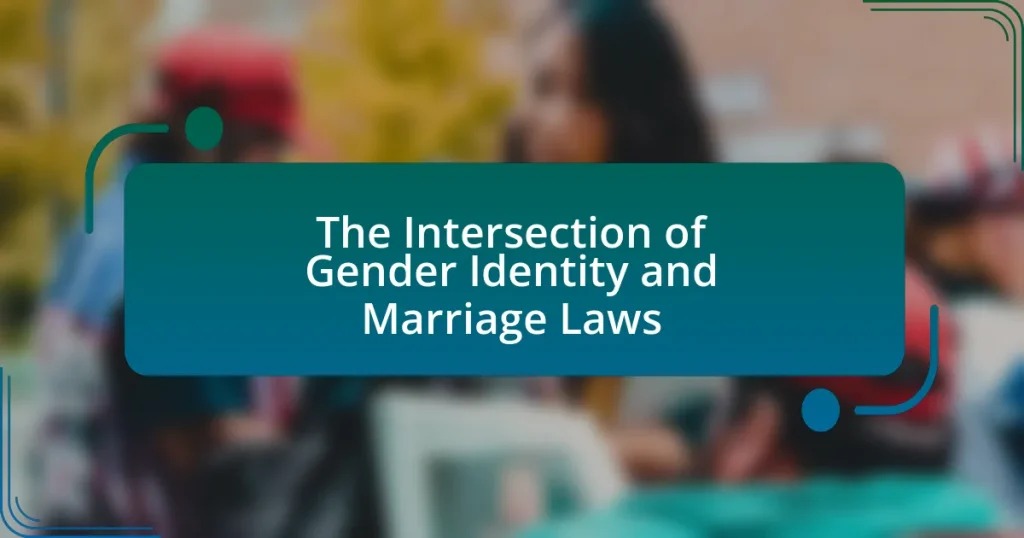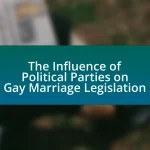The article examines the intersection of gender identity and marriage laws, focusing on how legal definitions and regulations surrounding marriage accommodate or conflict with individuals’ gender identities. It highlights the evolution of marriage laws in various jurisdictions, particularly the recognition of same-sex marriages and the rights of transgender individuals, as exemplified by landmark cases like Obergefell v. Hodges. The article also explores the cultural, historical, and legal frameworks that shape these interactions, the challenges faced by individuals at this intersection, and the implications of marriage laws on gender identity rights and social acceptance. Additionally, it discusses global trends, significant progress in certain countries, and the role of advocacy and technology in advancing gender identity rights within marriage legislation.
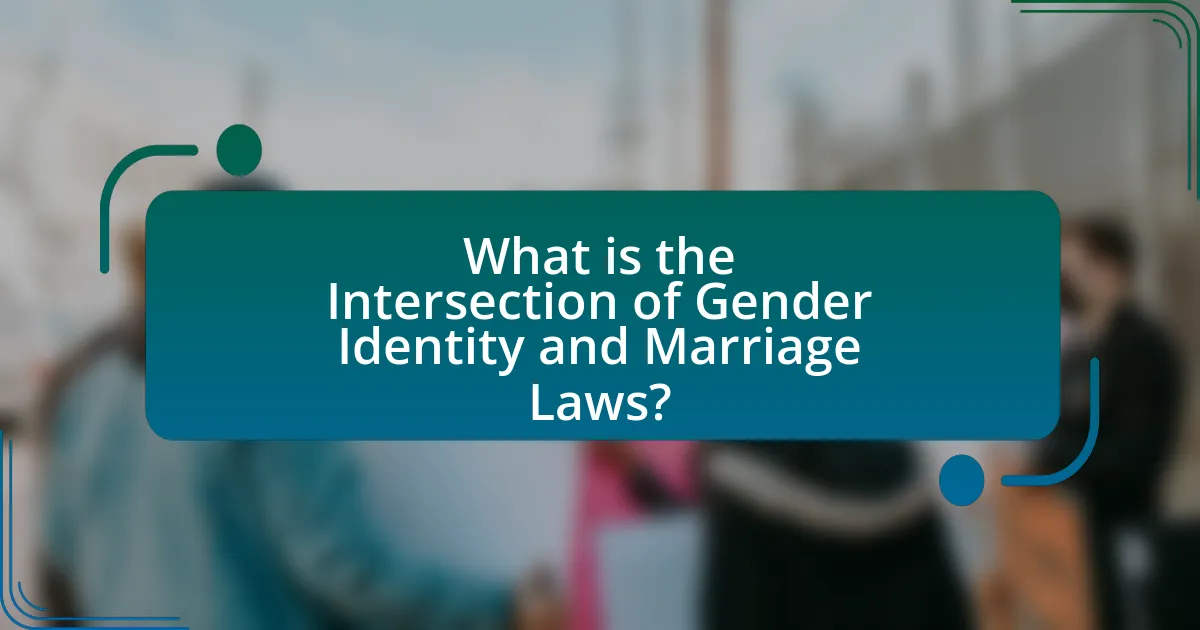
What is the Intersection of Gender Identity and Marriage Laws?
The intersection of gender identity and marriage laws refers to how legal definitions and regulations surrounding marriage accommodate or conflict with individuals’ gender identities. In many jurisdictions, marriage laws have evolved to recognize same-sex marriages and the rights of transgender individuals, reflecting a broader understanding of gender beyond the binary framework. For instance, the U.S. Supreme Court’s decision in Obergefell v. Hodges (2015) legalized same-sex marriage nationwide, affirming that marriage is a fundamental right regardless of gender identity. This legal recognition has significant implications for issues such as spousal rights, adoption, and healthcare decisions, highlighting the necessity for inclusive marriage laws that respect and affirm diverse gender identities.
How do gender identity and marriage laws interact in different societies?
Gender identity and marriage laws interact in various ways across different societies, influencing the legal recognition of relationships and the rights of individuals. In many Western countries, such as the United States and Canada, marriage laws have evolved to include same-sex couples, reflecting a growing acceptance of diverse gender identities. For instance, the U.S. Supreme Court’s decision in Obergefell v. Hodges (2015) legalized same-sex marriage nationwide, affirming the rights of individuals regardless of gender identity. Conversely, in some societies, such as in parts of the Middle East and Africa, marriage laws remain strictly defined by traditional gender roles, often excluding recognition of non-binary or transgender identities, which can lead to legal and social discrimination. This disparity highlights how cultural, religious, and legal frameworks shape the interaction between gender identity and marriage laws, resulting in varying degrees of acceptance and rights for individuals based on their gender identity.
What historical contexts have shaped the relationship between gender identity and marriage laws?
The relationship between gender identity and marriage laws has been shaped by various historical contexts, including legal, social, and cultural developments. For instance, the establishment of marriage as a legal institution in many societies historically defined marriage as a union between a man and a woman, reflecting patriarchal norms that marginalized non-binary and same-sex identities. The 20th century saw significant shifts, particularly with the LGBTQ+ rights movement, which challenged traditional definitions of gender and marriage. Landmark legal cases, such as Obergefell v. Hodges in 2015, which legalized same-sex marriage in the United States, exemplify how changing societal attitudes towards gender identity have influenced marriage laws. Additionally, the recognition of transgender rights and the ability to change legal gender markers have further impacted marriage laws, allowing for more inclusive definitions of marriage that acknowledge diverse gender identities.
How do cultural perceptions of gender identity influence marriage legislation?
Cultural perceptions of gender identity significantly influence marriage legislation by shaping societal norms and legal frameworks regarding marriage. In societies where traditional gender roles are upheld, legislation often reflects these views, limiting marriage to heterosexual couples and reinforcing binary gender identities. For instance, countries like Saudi Arabia and Iran have laws that strictly prohibit same-sex marriage, rooted in cultural and religious beliefs about gender. Conversely, in more progressive societies, such as Canada and the Netherlands, evolving cultural perceptions have led to the legalization of same-sex marriage, reflecting a broader acceptance of diverse gender identities. This shift is evidenced by the 2005 legalization of same-sex marriage in Canada, which was influenced by changing public attitudes and advocacy for LGBTQ+ rights. Thus, cultural perceptions directly shape the legal recognition and rights associated with marriage, illustrating the dynamic interplay between societal values and legislative action.
What are the key legal frameworks surrounding gender identity and marriage?
The key legal frameworks surrounding gender identity and marriage include anti-discrimination laws, marriage equality legislation, and policies regarding gender recognition. Anti-discrimination laws, such as the Equality Act in the United States, prohibit discrimination based on gender identity in various sectors, including employment and housing. Marriage equality legislation, exemplified by the Obergefell v. Hodges decision in 2015, legalized same-sex marriage nationwide, affirming the rights of individuals regardless of gender identity. Additionally, policies regarding gender recognition, such as those allowing individuals to change their gender markers on identification documents, are crucial for ensuring that transgender and non-binary individuals can marry in accordance with their gender identity. These frameworks collectively support the rights of individuals in the context of marriage and gender identity.
What are the major legal definitions of gender identity in various jurisdictions?
Major legal definitions of gender identity vary across jurisdictions, with some recognizing it as a self-identified characteristic while others impose specific criteria. In the United States, for instance, the Equality Act defines gender identity as an individual’s internal sense of their gender, which may differ from the sex assigned at birth. In Canada, the Canadian Human Rights Act includes gender identity as a prohibited ground of discrimination, affirming the right of individuals to identify as they choose. The United Kingdom’s Gender Recognition Act allows individuals to obtain legal recognition of their gender identity through a formal process, emphasizing the importance of medical assessments. In Australia, various states have different laws, with some recognizing gender identity in anti-discrimination legislation, while others require surgical intervention for legal recognition. These definitions reflect a growing acknowledgment of gender diversity, though the legal frameworks remain inconsistent globally.
How do marriage laws accommodate or challenge diverse gender identities?
Marriage laws accommodate diverse gender identities by recognizing same-sex marriages and allowing individuals to marry in accordance with their gender identity. For instance, countries like Canada and the Netherlands have legalized same-sex marriage, affirming the rights of LGBTQ+ individuals to marry, which supports their gender identity. Conversely, many jurisdictions challenge diverse gender identities by enforcing traditional definitions of marriage that exclude non-binary and transgender individuals from legal recognition. In the United States, for example, some states have laws that do not recognize gender changes on marriage licenses, thereby invalidating the marriages of transgender individuals if their gender identity does not align with the gender assigned at birth. This legal inconsistency creates barriers for individuals seeking to have their identities validated within the institution of marriage.
What challenges do individuals face at the intersection of gender identity and marriage laws?
Individuals face significant challenges at the intersection of gender identity and marriage laws, primarily due to legal recognition and discrimination. Many jurisdictions do not recognize non-binary or transgender identities, leading to difficulties in obtaining marriage licenses that reflect their gender identity. For instance, in the United States, some states have laws that require individuals to undergo surgery to change their gender marker on identification documents, which can hinder their ability to marry in accordance with their identity. Additionally, individuals may encounter social stigma and discrimination from both legal authorities and society, which can result in emotional distress and barriers to accessing legal protections afforded to married couples. These challenges are compounded by varying state laws, creating a patchwork of rights and recognition that can leave individuals vulnerable and without adequate legal recourse.
What legal obstacles exist for same-sex couples in different regions?
Legal obstacles for same-sex couples vary significantly across different regions, often including the lack of legal recognition for same-sex marriages, restrictions on adoption rights, and discriminatory laws that affect healthcare and employment. For instance, in many countries in Africa and the Middle East, same-sex relationships are criminalized, leading to severe penalties, while in parts of the United States, some states have enacted laws that allow businesses to refuse services to same-sex couples based on religious beliefs. According to a 2021 report by the International Lesbian, Gay, Bisexual, Trans and Intersex Association, 69 countries still criminalize same-sex relationships, highlighting the widespread legal challenges faced by same-sex couples globally.
How do discriminatory practices affect the rights of transgender individuals in marriage?
Discriminatory practices significantly undermine the rights of transgender individuals in marriage by creating legal and social barriers that prevent equal recognition and protection. For instance, many jurisdictions do not recognize the gender identity of transgender individuals, leading to complications in marriage licenses, spousal rights, and the ability to adopt children. Research from the Williams Institute indicates that transgender individuals face higher rates of discrimination in legal settings, which can result in denial of marriage rights or unequal treatment in divorce proceedings. This systemic discrimination not only affects legal recognition but also contributes to social stigma, further marginalizing transgender individuals within the institution of marriage.
How have recent changes in marriage laws impacted gender identity recognition?
Recent changes in marriage laws have significantly enhanced gender identity recognition by legally acknowledging non-binary and transgender identities in various jurisdictions. For instance, countries like Canada and Germany have implemented policies allowing individuals to select gender-neutral options on marriage licenses, which validates diverse gender identities. This legal recognition fosters social acceptance and encourages the visibility of gender-diverse individuals, as evidenced by increased advocacy and support for LGBTQ+ rights following such legislative changes.
What role do landmark court cases play in shaping marriage laws related to gender identity?
Landmark court cases play a crucial role in shaping marriage laws related to gender identity by establishing legal precedents that affirm the rights of individuals to marry regardless of their gender identity. For instance, the Supreme Court’s decision in Obergefell v. Hodges (2015) legalized same-sex marriage nationwide, directly impacting marriage laws and reinforcing the principle that marriage is a fundamental right for all, including transgender and non-binary individuals. This ruling has influenced subsequent cases and legislation, promoting greater acceptance and legal recognition of diverse gender identities within the context of marriage.
How have public opinions shifted regarding gender identity and marriage laws?
Public opinions regarding gender identity and marriage laws have shifted significantly towards greater acceptance and support over the past two decades. According to a 2021 Gallup poll, 70% of Americans now support same-sex marriage, a substantial increase from just 27% in 1996. Additionally, attitudes towards transgender rights have also evolved, with a 2020 Pew Research Center survey indicating that 62% of Americans believe that gender identity should be recognized and protected under the law. This shift reflects broader societal changes, including increased visibility of LGBTQ+ individuals in media and advocacy efforts that have raised awareness about gender identity issues.
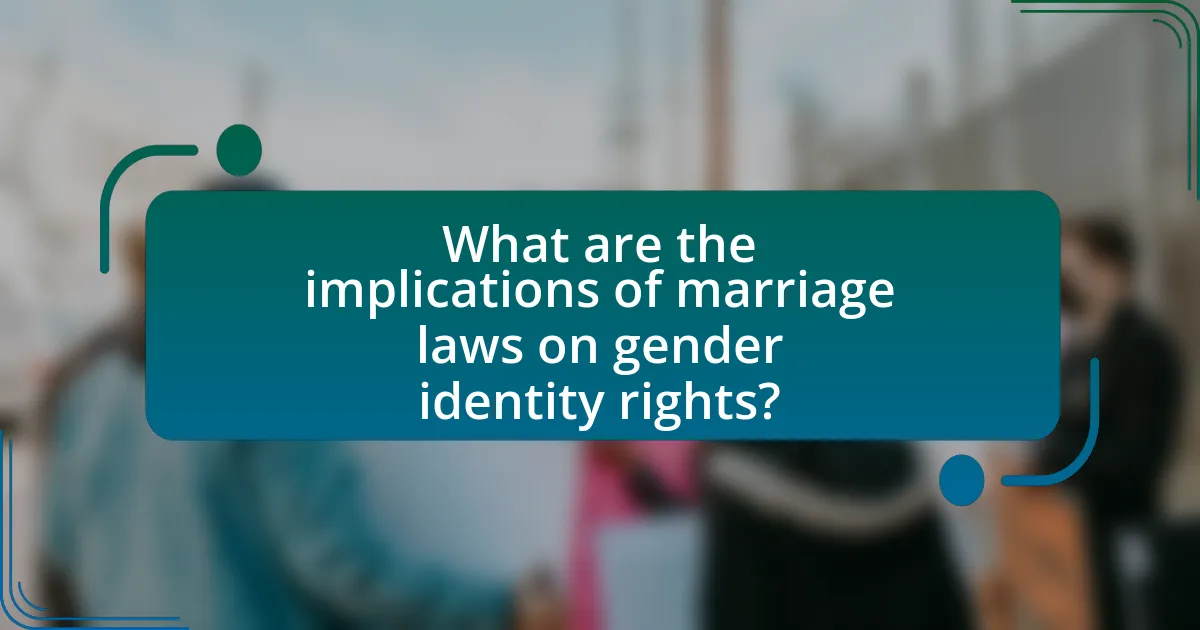
What are the implications of marriage laws on gender identity rights?
Marriage laws significantly impact gender identity rights by determining the legal recognition and protections afforded to individuals based on their gender identity. For instance, jurisdictions that recognize same-sex marriage often extend rights related to adoption, inheritance, and healthcare decisions to LGBTQ+ individuals, thereby affirming their gender identity within a legal framework. Conversely, regions with restrictive marriage laws may deny these rights, leading to discrimination and marginalization of transgender and non-binary individuals. Research from the Williams Institute indicates that legal recognition of same-sex marriage correlates with improved mental health outcomes for LGBTQ+ individuals, highlighting the importance of inclusive marriage laws in supporting gender identity rights.
How do marriage laws affect the social acceptance of diverse gender identities?
Marriage laws significantly influence the social acceptance of diverse gender identities by legitimizing relationships that challenge traditional gender norms. When jurisdictions enact inclusive marriage laws, such as recognizing same-sex marriage or allowing non-binary individuals to marry, they validate the existence and rights of these identities within society. For instance, the legalization of same-sex marriage in the United States in 2015 led to increased visibility and acceptance of LGBTQ+ individuals, as evidenced by a Gallup poll showing that acceptance of same-sex relationships rose from 40% in 2001 to 70% in 2021. This legal recognition fosters a cultural shift, encouraging broader societal acceptance and reducing stigma associated with diverse gender identities.
What impact do marriage rights have on the mental health of gender-diverse individuals?
Marriage rights significantly improve the mental health of gender-diverse individuals by providing legal recognition and social validation. Studies indicate that access to marriage correlates with lower rates of depression and anxiety among LGBTQ+ populations. For instance, research published in the American Journal of Public Health found that states allowing same-sex marriage reported a 7% decrease in suicide rates among LGBTQ+ youth, highlighting the positive impact of legal recognition on mental well-being. Furthermore, marriage rights foster a sense of belonging and acceptance, which are crucial for mental health, as they reduce stigma and discrimination faced by gender-diverse individuals.
How do legal recognitions of gender identity influence family dynamics?
Legal recognitions of gender identity significantly influence family dynamics by validating and affirming the identities of family members, which can lead to improved relationships and communication. When legal systems recognize diverse gender identities, families often experience reduced stigma and increased acceptance, fostering a supportive environment. Research indicates that families with legally recognized transgender members report higher levels of emotional well-being and cohesion. For instance, a study published in the Journal of Family Psychology found that legal recognition correlates with lower rates of family conflict and higher satisfaction in familial relationships, demonstrating the positive impact of such legal frameworks on family dynamics.
What are the global trends in marriage laws concerning gender identity?
Global trends in marriage laws concerning gender identity show a significant shift towards inclusivity and recognition of diverse gender identities. Many countries are increasingly adopting legal frameworks that allow for same-sex marriage and the recognition of non-binary and transgender individuals in marriage laws. For instance, as of 2023, over 30 countries have legalized same-sex marriage, reflecting a growing acceptance of LGBTQ+ rights. Additionally, nations like Canada and Argentina have implemented laws that allow individuals to change their gender markers on marriage certificates, further validating their gender identity. This trend is supported by international human rights organizations advocating for equality, emphasizing that marriage laws must evolve to reflect the rights of all individuals, regardless of gender identity.
Which countries have made significant progress in recognizing gender identity in marriage laws?
Countries that have made significant progress in recognizing gender identity in marriage laws include Argentina, Canada, Germany, Malta, and the Netherlands. Argentina was the first country in Latin America to legalize same-sex marriage in 2010 and has laws that allow individuals to change their gender identity on official documents without surgery. Canada legalized same-sex marriage nationwide in 2005 and recognizes gender identity in its marriage laws. Germany passed a law in 2018 allowing individuals to choose a third gender option on birth certificates, reflecting broader recognition of gender identity. Malta has comprehensive gender identity laws, including the Gender Identity, Gender Expression, and Sex Characteristics Act of 2015, which allows individuals to change their legal gender. The Netherlands was the first country to legalize same-sex marriage in 2001 and has since recognized gender identity in its marriage laws.
What lessons can be learned from countries with inclusive marriage legislation?
Countries with inclusive marriage legislation demonstrate that legal recognition of diverse gender identities fosters social acceptance and reduces discrimination. For instance, nations like Canada and the Netherlands, which legalized same-sex marriage early, have seen significant improvements in mental health outcomes among LGBTQ+ individuals, as evidenced by studies showing lower rates of depression and anxiety in these populations post-legalization. Furthermore, inclusive marriage laws contribute to economic benefits, as seen in the U.S. where states that legalized same-sex marriage experienced increased wedding-related revenues. These examples illustrate that inclusive legislation not only affirms individual rights but also promotes broader societal well-being and economic growth.
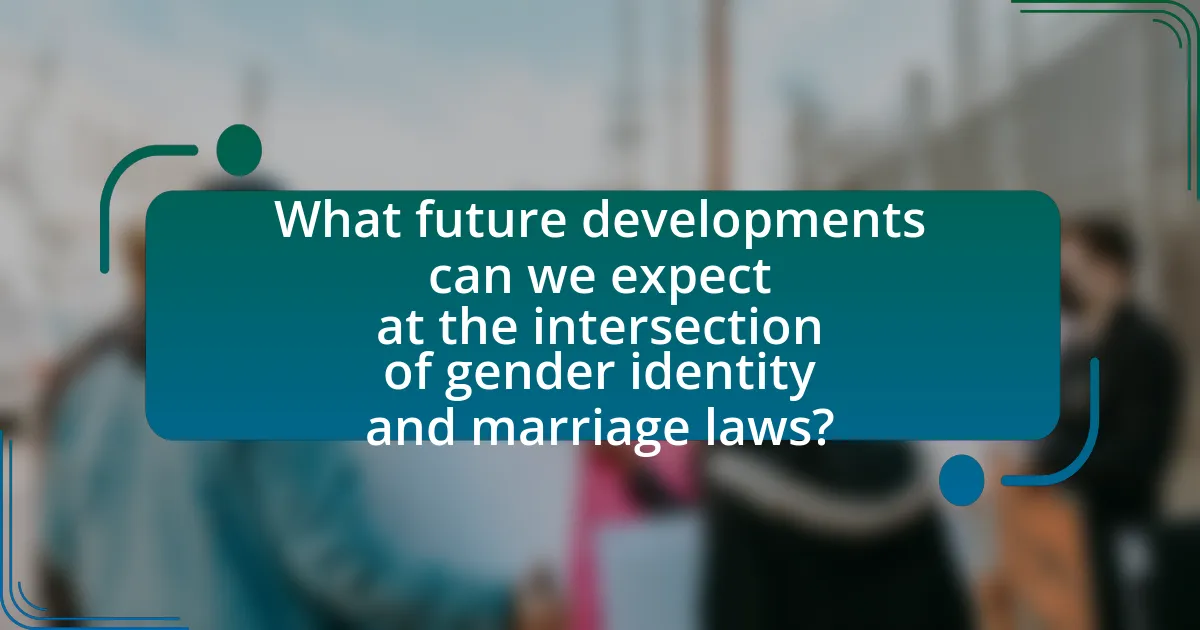
What future developments can we expect at the intersection of gender identity and marriage laws?
Future developments at the intersection of gender identity and marriage laws are likely to include broader legal recognition of non-binary and transgender identities in marriage legislation. As societal acceptance of diverse gender identities increases, more jurisdictions are expected to amend their marriage laws to allow for gender-neutral options on marriage certificates and to recognize marriages involving individuals who identify outside the traditional binary framework. For instance, countries like Canada and Germany have already implemented such changes, reflecting a trend towards inclusivity. Additionally, ongoing legal challenges and advocacy efforts are likely to push for the elimination of discriminatory practices in marriage laws, further shaping the legal landscape to be more accommodating of all gender identities.
How might emerging social movements influence marriage laws related to gender identity?
Emerging social movements significantly influence marriage laws related to gender identity by advocating for legal recognition and protections for diverse gender identities. These movements, such as those promoting transgender rights and non-binary recognition, have led to legislative changes in various jurisdictions, including the introduction of gender-neutral marriage licenses and the removal of requirements for gender conformity in marriage applications. For instance, in 2015, the U.S. Supreme Court’s decision in Obergefell v. Hodges, which legalized same-sex marriage, was heavily influenced by social movements advocating for LGBTQ+ rights, demonstrating how activism can reshape legal frameworks. Additionally, countries like Canada and Germany have amended their marriage laws to include non-binary options, reflecting the impact of grassroots advocacy on policy reform.
What role does technology play in advocating for gender identity rights in marriage?
Technology plays a crucial role in advocating for gender identity rights in marriage by facilitating communication, raising awareness, and mobilizing support. Social media platforms enable individuals and organizations to share personal stories and experiences, which can humanize the issues surrounding gender identity and marriage rights. For instance, campaigns like #LoveIsLove have gained traction online, promoting acceptance and legal recognition of same-sex marriages and diverse gender identities. Additionally, technology provides tools for organizing events, such as virtual rallies and petitions, which can amplify voices and influence policymakers. Research indicates that online activism has significantly impacted public opinion and legislative changes regarding marriage equality, demonstrating the effectiveness of technology in advancing gender identity rights.
What practical steps can individuals take to navigate marriage laws related to gender identity?
Individuals can navigate marriage laws related to gender identity by researching local and national legal frameworks that govern marriage rights for transgender and non-binary individuals. Understanding the specific requirements for legal recognition of gender identity, such as name and gender marker changes on identification documents, is crucial. For instance, many jurisdictions require individuals to provide proof of gender transition, which may include medical documentation or court orders.
Additionally, consulting with legal experts or organizations specializing in LGBTQ+ rights can provide tailored guidance on navigating the complexities of marriage laws. Resources such as the Human Rights Campaign and Lambda Legal offer comprehensive information on legal rights and processes. Engaging with local advocacy groups can also help individuals stay informed about any changes in legislation that may affect their marriage rights.
How can individuals advocate for their rights within existing legal frameworks?
Individuals can advocate for their rights within existing legal frameworks by engaging in legal literacy, participating in advocacy groups, and utilizing formal complaint mechanisms. Legal literacy enables individuals to understand their rights and the laws that protect them, which is essential for effective advocacy. Advocacy groups, such as LGBTQ+ organizations, provide resources, support, and collective power to influence policy changes and raise awareness about issues related to gender identity and marriage laws. Additionally, individuals can file complaints with relevant authorities or pursue legal action when their rights are violated, as demonstrated by cases like Obergefell v. Hodges, which affirmed the right to same-sex marriage in the United States, showcasing the impact of legal advocacy on advancing rights within established legal frameworks.
What resources are available for those seeking legal assistance in marriage and gender identity issues?
Legal assistance for marriage and gender identity issues can be accessed through various resources, including nonprofit organizations, legal aid societies, and specialized law firms. Organizations such as the Human Rights Campaign and Lambda Legal provide legal resources, advocacy, and support specifically for LGBTQ+ individuals facing marriage and gender identity challenges. Additionally, local legal aid offices often offer free or low-cost legal services to those in need, ensuring access to legal representation. Furthermore, many states have bar associations that can connect individuals with attorneys who specialize in family law and gender identity issues, enhancing the availability of tailored legal assistance.
